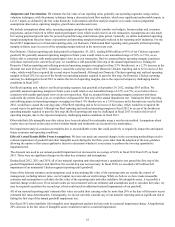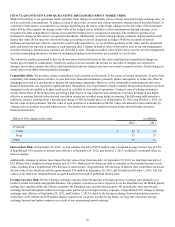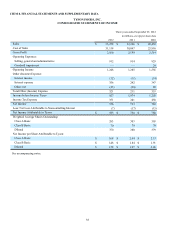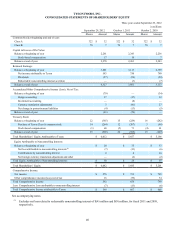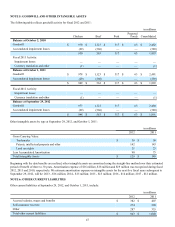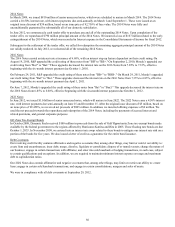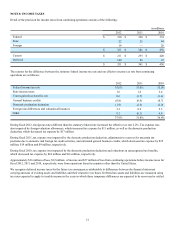Tyson Foods 2012 Annual Report Download - page 45
Download and view the complete annual report
Please find page 45 of the 2012 Tyson Foods annual report below. You can navigate through the pages in the report by either clicking on the pages listed below, or by using the keyword search tool below to find specific information within the annual report.45
Financial Instruments: We purchase certain commodities, such as grains and livestock in the course of normal operations. As part of
our commodity risk management activities, we use derivative financial instruments, primarily futures and options, to reduce our
exposure to various market risks related to these purchases, as well as to changes in foreign currency exchange rates. Contract terms of
a financial instrument qualifying as a hedge instrument closely mirror those of the hedged item, providing a high degree of risk
reduction and correlation. Contracts designated and highly effective at meeting risk reduction and correlation criteria are recorded
using hedge accounting. If a derivative instrument is accounted for as a hedge, changes in the fair value of the instrument will be offset
either against the change in fair value of the hedged assets, liabilities or firm commitments through earnings or recognized in other
comprehensive income (loss) until the hedged item is recognized in earnings. The ineffective portion of an instrument’s change in fair
value is immediately recognized in earnings as a component of cost of sales. Instruments we hold as part of our risk management
activities that do not meet the criteria for hedge accounting are marked to fair value with unrealized gains or losses reported currently
in earnings. Changes in market value of derivatives used in our risk management activities relating to forward sales contracts are
recorded in sales, while changes surrounding inventories on hand or anticipated purchases of inventories or supplies are recorded in
cost of sales. We generally do not hedge anticipated transactions beyond 18 months.
Revenue Recognition: We recognize revenue when title and risk of loss are transferred to customers, which is generally on delivery
based on terms of sale. Revenue is recognized as the net amount estimated to be received after deducting estimated amounts for
discounts, trade allowances and product terms.
Litigation Reserves: There are a variety of legal proceedings pending or threatened against us. Accruals are recorded when it is
probable a liability has been incurred and the amount of the liability can be reasonably estimated based on current law, progress of
each case, opinions and views of legal counsel and other advisers, our experience in similar matters and intended response to the
litigation. These amounts, which are not discounted and are exclusive of claims against third parties, are adjusted periodically as
assessment efforts progress or additional information becomes available. We expense amounts for administering or litigating claims as
incurred. Accruals for legal proceedings are included in Other current liabilities in the Consolidated Balance Sheets.
Freight Expense: Freight expense associated with products shipped to customers is recognized in cost of sales.
Advertising and Promotion Expenses: Advertising and promotion expenses are charged to operations in the period incurred.
Customer incentive and trade promotion activities are recorded as a reduction to sales based on amounts estimated as being due to
customers, based primarily on historical utilization and redemption rates, while other advertising and promotional activities are
recorded as selling, general and administrative expenses. Advertising and promotion expenses for fiscal 2012, 2011 and 2010 were
$496 million, $552 million and $505 million, respectively.
Research and Development: Research and development costs are expensed as incurred. Research and development costs totaled $43
million, $42 million and $38 million in fiscal 2012, 2011 and 2010, respectively.
Use of Estimates: The consolidated financial statements are prepared in conformity with accounting principles generally accepted in
the United States, which require us to make estimates and assumptions that affect the amounts reported in the consolidated financial
statements and accompanying notes. Actual results could differ from those estimates.
Recently Issued Accounting Pronouncements:
In June 2011, the Financial Accounting Standards Board (FASB) issued guidance regarding the presentation of comprehensive
income. This guidance is effective for annual periods, and interim periods within those years, beginning after December 15, 2011. We
will adopt this guidance in the first quarter of fiscal 2013. Upon adoption, we will be required to present comprehensive income as
part of our consolidated statements of income, or in a separate financial statement. Currently, we present such information in our notes
to the consolidated financial statements. Other than changing the presentation of comprehensive income, we do not expect the
adoption will have a significant impact on our consolidated financial statements.
In December 2011, the FASB issued guidance enhancing disclosures related to offsetting of certain assets and liabilities. This guidance
is effective for annual reporting periods beginning on or after January 1, 2013, and interim periods within those annual periods. We do
not expect the adoption will have a significant impact on our consolidated financial statements.


